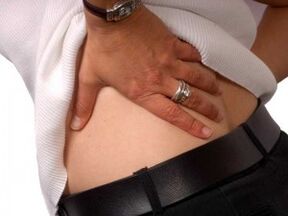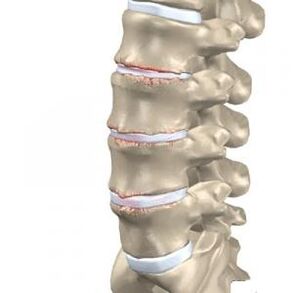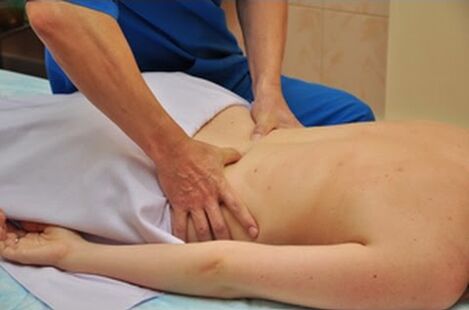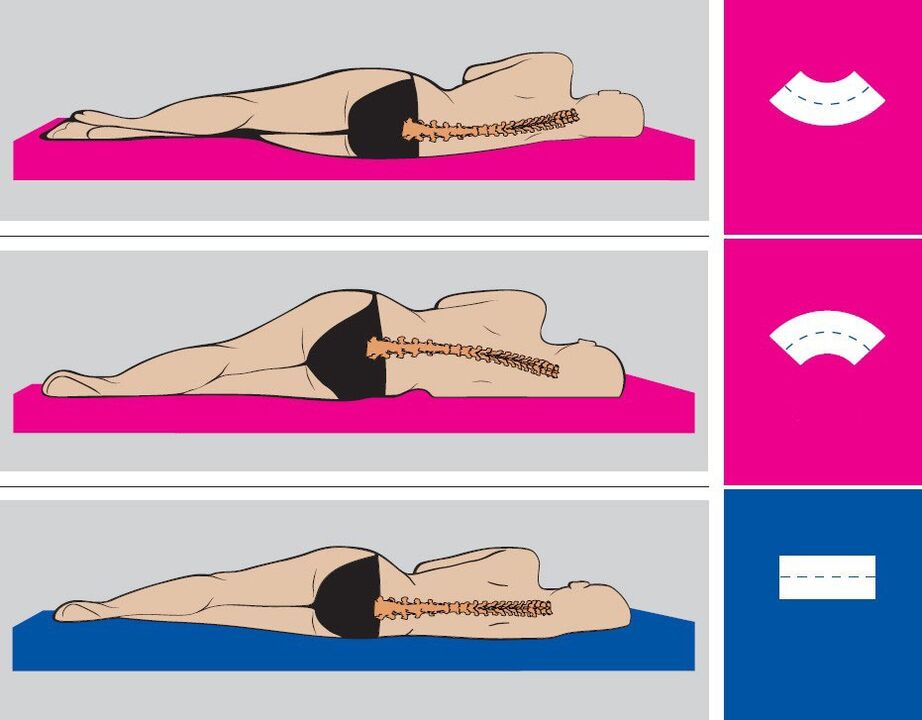
One of the most common diseases todayOsteochondrosis of the lumbar spine. Both men and women are equally likely to consult doctors with this condition.
Each of us has experienced pain in the lower back, sacrum or lower extremities at least once in our lives. We often unknowingly call this type of pain "pinched lower back nerve. "
Causes of lumbar osteochondrosis
According to research by doctors and scientists, the main cause of osteochondrosis of the lumbar spine is an upright posture. However, not all people suffer from osteochondrosis. Provoking factors that accelerate the development of the disease are: metabolic disorders, lack of exercise, injuries, excess weight, improper lifting of weights.
The source of pain in osteochondrosis is pinched nerve roots, which occur after the protrusion of the intervertebral disc and the narrowing of the intervertebral space. This deviation occurs when nutrition deteriorates and the natural processes of oxygen and lymphatic exchange in the tissues of the intervertebral discs are disrupted. As a result, the shock absorption ability of the intervertebral discs decreases and the nucleus pulposus of the intervertebral disc gradually deteriorates and dries out.
From an anatomical point of view, lumbar osteochondrosis is a process of transformation of cartilage into bone, which leads to excessive pressure on the nerve roots that originate from the spinal cord. This change causes pain. Overgrowth of bone tissue occurs due to deterioration in the nutrition of the intervertebral discs, loss of fluid and disruption of structure and function.
If the protrusion of the intervertebral disc becomes more severe during the development of osteochondrosis of the lumbar spine, it leads to the development of lumbar protrusion and disc herniation due to the rupture of the fibrous ring.
The pain syndrome arises from pinching of the spinal nerve in lumbar osteochondrosis and is called lumbosciatica. This symptom is accompanied by numbness of the lower extremities. Depending on the type and location of the pain, the disease can be divided into sciatica and lumbago. Inflammation of a nerve due to its entrapment is called radiculitis. In fact, methods of treating radiculitis with painkillers only serve to eliminate symptoms and are ineffective, since such treatment does not affect the true cause of the disease, namely degenerative processes in the intervertebral discs. To eliminate pain and take preventive measures to avoid complications, you need to undergo comprehensive treatment to activate restorative processes in the intervertebral disc tissue and normalize the height and physiological parameters of the intervertebral discs.
Symptoms of osteochondrosis of the lumbar spine

One of the signs of osteochondrosis is compression of the spinal nerve roots by the protruding nucleus pulposus of the intervertebral disc. This compression occurs in the epidural space, a type of container for the spinal roots. Osteochondrosis of the lumbar spine is manifested by the following symptoms, which correspond to root compression:
- L1 and L2 – loss of sensitivity in the "breeches" area, namely in the groin area and on the inner thighs. Pain can occur in both legs at the same time if lumbar osteochondrosis is complicated by the development of an inguinal hernia.
- L5 – stabbing pain, decreased sensitivity in the lower back and thumb, and decreased ability to flex the finger.
- S1 – stabbing pain, decreased sensitivity of the lower leg and outer thigh, pain in the foot from the little toe to the fourth toe. When this root is damaged, Achilles tendon and plantar reflexes are often lost.
- Damage to the Deproge-Gotteron artery - in the chronic course of osteochondrosis, paralysis of the lower leg and buttocks may occur, and sensitivity in the anogenital area may disappear.
- Simultaneous damage to the L5, S roots, and Deproge-Gotteron artery results in "crippling sciatica" syndrome and loss of pelvic and motor functions.
Osteochondrosis of the lumbar spine can lead to bulges and hernias due to the significant load on this part of the spine. These complications develop very quickly, so it is very important to treat them in a timely manner. Do not delay your visit to the vertebral doctor, undergo a comprehensive examination and seek qualified help at the first symptoms of lumbar osteochondrosis.
Complications of osteochondrosis of the lumbar spine
Compression vascular ischemia can be considered a complication of lumbar osteochondrosis. This pathology arises due to impaired blood supply to the spinal cord, a reduction in the intervertebral openings for vessels and arteries, and a narrowing of the peripheral structures of the vertebrae. The reason for the development of this pathology is flattening of the intervertebral discs, excessive mobility of the spine, weakened ligaments, the formation of osteophytes and neoarthrosis. Any movement of the spine that affects the damaged area will cause permanent injury and pressure on a pinched vessel or artery. In addition, there may be a reflex narrowing of the vessel that passes through the clamped opening of the canal. This effect is called "narrow bed".
Vertebrologists identify another serious complication of osteochondrosis of the lumbar spine. Compressive myelopathy is a spinal cord disease caused by narrowing of the spinal canal. Depending on the localization, symptoms and severity of the pathology may vary. Most often, the course of the disease is characterized by episodes - after an attack there is a period of remission.
Lumbar osteochondrosis can be complicated by a TXII-L1 disc herniation, which exerts pressure and causes damage to the S1-S2, L2-L-4 segments of the spinal cord. A patient with this complication experiences pain in the lower back, lower leg, hamstring, and weakness in the legs. The gluteal and calf muscles gradually become hypotonic and hypotrophic, the Achilles tendon and plantar reflexes fail, and foot paresis occurs. The back and outer surfaces of the foot and lower leg are characterized by reduced sensitivity or its complete absence.
If a LI-II disc herniation occurs, in which excessive pressure on the S3 coccyx segment increases, with osteochondrosis of the lumbar spine, the following symptoms occur: disruption of the pelvic organs, fecal and urinary incontinence, constipation, loss or decrease in sensitivity of the anogenital area, Development of pressure ulcers, anal prolapse reflex.
The "cauda equina syndrome" occurs when the nerve roots from the first lumbar vertebra and below are compressed. An experienced vertebrologist notes that this syndrome most often occurs in patients with congenital narrowing of the spinal canal. The "cauda equina" is a bundle of nerve roots, which contains the terminal roots of the spinal cord from the first segment onwards. The name came about because of its resemblance to a horse's tail. The diagnosis of this syndrome largely depends on the presence of excruciating pain of a radicular nature. It is this feature that distinguishes cauda equina syndrome from other complications that do not involve acute pain.
Cauda equina syndrome is characterized by severe pain in the sacrum and lower back, radiating to the buttocks, anogenital area and the posterior surface of the thigh. In some cases, paresis, peripheral paralysis and sensory disorders occur. In severe cases, paralysis of the buttocks and both legs occurs. The asymmetry of sensory and motor disorders can be considered a characteristic feature of the complication.
Lumbar osteochondrosis can cause the development of myeloid "intermittent claudication" syndrome, in which there is weakness in the legs when walking, frequent urge to urinate and numbness in the lower body. The cause of these complaints is poor blood supply to the lower parts of the spinal cord. According toWith rest these sensations disappear.
With ischemia of the roots of the cauda equina, caudogenic "intermittent claudication" occurs - goosebumps and tingling when walking. Over time, this symptom can become more severe and reach the perineum, genitals and groin. The weakness in the legs disappearsa short rest.
Compression of the artery of Adamkiewicz can occur due to unsuccessful sudden movements, heavy lifting, or shaking. This complication of osteochondrosis of the lumbar spine is manifested by disorders of the pelvic organs, loss of sensitivity, the appearance of bedsores and atrophy of the leg muscles.
Osteochondrosis of the lumbar spine is manifested by aching pain in the lower back. Staying in an uncomfortable position for a long time can increase the pain. After sleeping or resting on your back, the pain decreases or disappears completely.
The occurrence of stressful situations for the body can lead to the development of an acute illness. This most often happens with hypothermia, heavy exertion and sudden movements. An exacerbation is characterized by severe pain that can extend from the lumbar region to the legs. The body can independently try to reduce the load on the affected part of the spine by tensing the lower back muscles. A patient with osteochondrosis of the lumbar spine tries to find a comfortable position in which the pain will subside.
Diagnosis of lumbar osteochondrosis
The diagnosis of osteochondrosis occurs in several stages. The doctor must talk to the patient, ask about complaints, find out about the nature of the pain, where it is localized, at what time the painful sensations become noticeable, how long they last, how severe they are, etc. In addition, theDoctor will find out under what conditions the pain occurs, when it increases or decreases.
The vertebral doctor then examines the anamnesis, i. e. H. History of the diseaseThe doctor will definitely clarify how long the painful condition lasts, what was the cause of the pain and how you feel during the time when the discomfort disappears. An important point is pretreatment and the effectiveness of certain treatment methods. A qualified doctor will definitely ask the patient about living and working conditions, freedom of movement, well-being under certain stresses and previous illnesses. It is very important to find out whether the patient had injuries to the spine, whether he played sports and whether immediate relatives had spinal diseases.
The next step in diagnosis is examining the patient. The doctor pays attention to the position of the head, legs and arms in relation to the body, the gait, posture, the symmetry of the body areas, the condition of the skin in the damaged area and the patient's movements. The range of motion of the spine and the extent of the damage are then determined. To do this, the doctor asks the patient to bend forward, to the side and back, move different parts of his back and tilt his head. A healthy person should not feel a crunch or pain in their joints during such a simple test.
If the patient does not suffer from osteochondrosis, he can reach his chest and shoulder with his chin. Head movements in each direction are approximately 60 degrees. By bending sideways between the head and the upper cervical spine, an angle of 45 degrees is created. The distance from the sacrum to the spinous process of the seventh cervical vertebra increases by 5-7 centimeters when bending forward. When bending back, this distance decreases by 5-6 cm. An experienced vertebral doctor will pay attention to how the knee and hip joints participate in flexion and how the configuration of the spine changes.
Treatment of osteochondrosis of the lumbar spine
Lumbar osteochondrosis requires complex, intensive and long-term treatment. This is especially true in chronic cases with multiple intervertebral hernias and bulges.
EffectiveTreatment of osteochondrosis of the lumbar spineis achieved by reflex methods that do not cause side effects but bring maximum benefit. Remember that recovery from such a serious illness cannot be quick. In each case of lumbar osteochondrosis, the doctor prescribes an individual treatment regimen.

It should be noted that manual therapy can be used only if the patient's spine is not damaged by protrusions and intervertebral hernias. The integrated use of these techniques allows you to restore normal blood microcirculation, eliminate congestion and vascular edema, relieve muscle spasms, restore the balance of metabolic processes in the tissues of the vertebrae and intervertebral discs, and also improve tissue nutrition in the lumbar region. This stimulates the natural regeneration process. It is worth noting that with lumbar osteochondrosis, manual therapy should be aimed at improving the functions of the spine.
The treatment procedures for lumbar osteochondrosis are complemented by the use of herbal remedies that improve innervation in the body, and also restore the balance of metabolic processes. The vertebral doctor will recommend patients to correct their diet and adopt a more active lifestyle. It is important to adjust your body weight, because excess weight puts additional pressure on the lower back and also promotes the development of osteochondrosis of the lumbar spine.
An experienced specialist treating osteochondrosis allows the patient to achieve serious results, avoid surgery, improve motor activity, eliminate pain in the lower back and comprehensively improve the body to prevent further exacerbations. Acute pain disappears after 1-3 sessions of manual therapy and the positive effect of the treatment occurs on average after 10-15 sessions. Remember that starting treatment on time is a guarantee of achieving positive results.
During the exacerbation of lower back pain, the patient is recommended to stay in bed for 2-3 days. For quick pain relief, non-steroidal anti-inflammatory drugs, painkillers, venotonics, diuretics, nicotinic acid and B vitamins are prescribed. To relieve the pressure on the spine, walking with crutches, dry or underwater traction of the spine can also be prescribed. If necessary, blocks with glucocorticoids or paravertebral blocks with an anesthetic are prescribed.
Physiotherapeutic treatment of osteochondrosis of the lumbar spine can also include electrophoresis, laser therapy and ultraviolet radiation. Physiotherapy is a mandatory part of a comprehensive treatment program. Some exercises can be performed in the acute stage, but it is recommended to perform almost all exercises after the pain has subsided. Through regular physical exercise, tissue nutrition is restored, blood and lymphatic supply to the intervertebral discs is improved, and the flexibility and elasticity of the joints and cartilage is gradually restored. As a result, the patient's condition improves and the interval between periods of exacerbation increases.
A spa treatment also has a positive effect on your health. Iodine-bromine, hydrogen sulfide and radon baths are mandatory in climatic health resorts.
Surgical treatment methods are used only when the patient's pain cannot be relieved by conservative methods for a long time, there is paresis of the muscles of the lower extremities and disruption of the processes of natural urination and defecation. During the operation, the herniated disc is removed and the spinal segment is strengthened.
Prevention of lumbar osteochondrosis

Prevention of lumbar osteochondrosis consists in following simple rules recommended by a vertebral doctor. Remember that the development of the disease can only be prevented by careful adherence to these rules, no matter what happens:
- Keep your lower back dry and warm, do not cool your spine too much and avoid drafts.
- Do not lift heavy objects or carry them long distances.
- Try not to make sudden movements.
- Maintain correct posture when working and resting.
- Change your position as often as possible and try not to stay in one position for too long.
- Do physical therapy.
- Try not to stay in a hunched position for a long time.
- To clean, use long mops, a broom, and a vacuum cleaner with a long hose so you don't have to bend over.
- Lift weights correctly: Bend over with your back straight or bend your knees, pick up the bags with your back straight and stand upright. Keep your hands with the load as close to your body as possible.
- If you need to bend low to pick something up from the floor, such as under a table or bed, get down on one knee and keep your back straight.
- Distribute the weights evenly between two hands.
- Strengthen your glutes, lengthen your spine, and take a walk every day.
- Maintain a balanced diet, enrich your diet with dairy and plant products.
- Stick to the drinking regime – 1. 5-2 liters of water and herbal teas per day.
- Get rid of bad habits – alcohol, smoking, drugs.




















